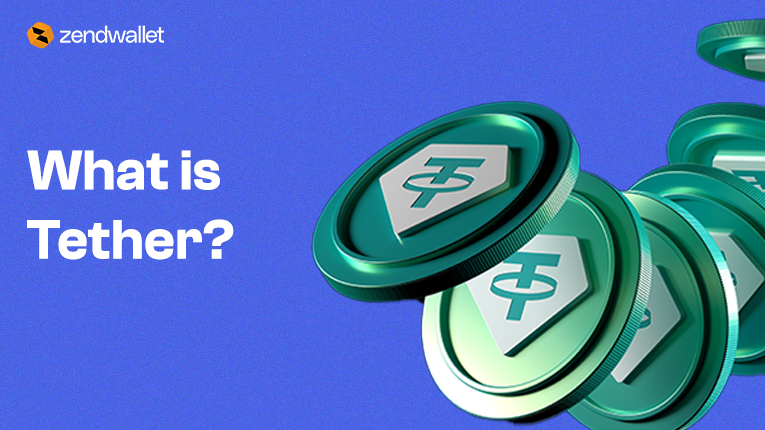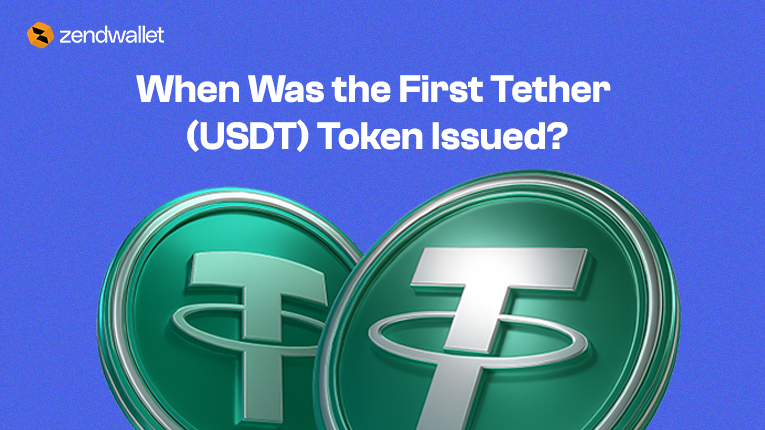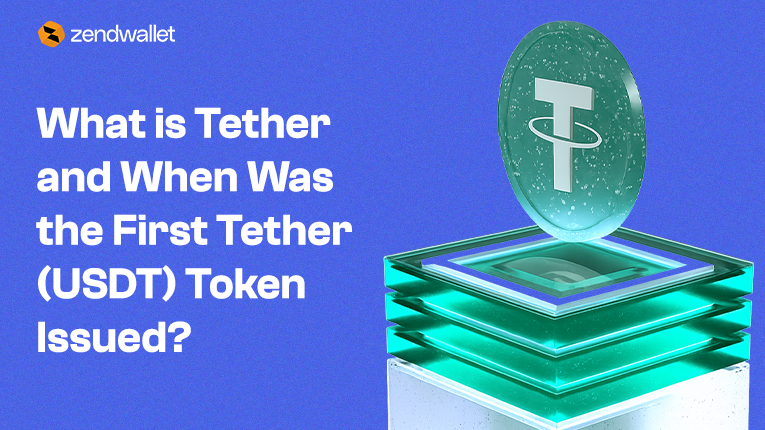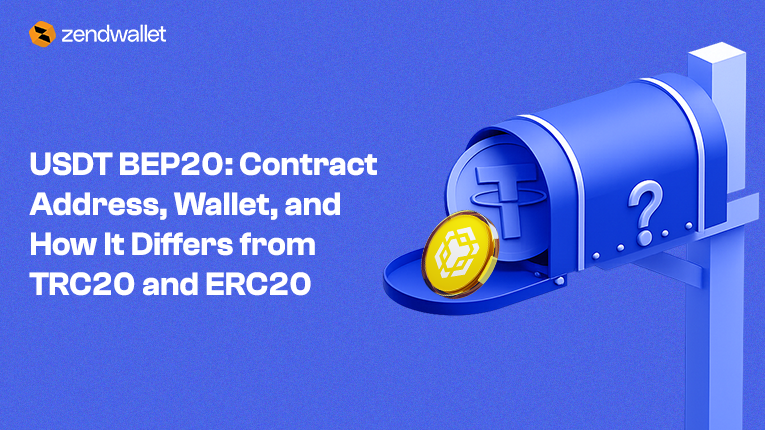What is Tether and When Was the First Tether (USDT) Token Issued?
If you have ever traded crypto or made a digital payment across borders, you’ve probably come across Tether (USDT).
It’s one of the most popular stablecoins in the world, known for making digital transactions simple, fast, and stable.
On ZendWallet, you can easily hold, trade, and send Tether (USDT) for payments or transfers across Africa and beyond.
What is Tether?

To the most curious question What is Tether?
Tether (USDT) is a type of stablecoin, a digital token designed to maintain a fixed value by being pegged to traditional currencies such as the U.S. Dollar, the Euro, or even gold.
Unlike cryptocurrencies that fluctuate in price, Tether aims to maintain a stable 1 USDT = $1 USD.
So, what is Tether used for? It’s mainly used to move money across crypto exchanges, make international payments, and store value digitally without worrying about market volatility.
Traders and businesses prefer Tether because it combines the stability of cash with the flexibility of blockchain.
Tether Limited, a blockchain-based financial services company, issues Tether. The firm holds real-world assets like cash, short-term deposits, and treasury bills to back every token in circulation.
This 1:1 peg assures users that every USDT can be redeemed for an equivalent amount of fiat currency.
You can Also Read: https://blog.zendwallet.com/usdt-trc20-contract-address/
When Was the First Tether (USDT) Token Issued?

Now to the big question: when was the first Tether (USDT) token issued?
The first Tether tokens were officially issued in October 2014, marking the start of a new era for digital finance.
Tether was originally launched as Realcoin in July 2014 by Brock Pierce, Craig Sellars, and Reeve Collins. Just a few months later, it was rebranded as Tether, a name that perfectly captured its purpose: tethering real-world money to the blockchain.
The first tokens were created on the Bitcoin blockchain using the Omni Layer protocol, which allowed users to send and receive USDT just like Bitcoin but with the added stability of being pegged to the U.S. Dollar.
USDT quickly gained popularity after major exchanges, such as Bitfinex, listed it in January 2015.
Over time, Tether expanded to other blockchains like Ethereum, Tron, and Solana, making it easier to integrate across wallets, exchanges, and payment systems worldwide.
Also Read: USDT BEP20: Contract Address, Wallet, and How It Differs from TRC20 and ERC20
Why Tether Remains Important
Since its first release in 2014, Tether (USDT) has become one of the most traded digital assets in the world. It plays a major role in how people send and use money in crypto, helping users make payments, manage funds, and trade without relying on traditional banks.
For everyday users, Tether represents speed, reliability, and access. You can send money across borders in minutes, store value without worrying about price drops, and transact anytime, anywhere.
On our ZendWallet app, users can easily convert, store, and spend Tether (USDT) through an app designed for clarity, trust, and convenience.
Tether’s growth also inspired many other stablecoins, but USDT remains the most widely used because of its liquidity, strong history, and leading role in both trading and cross-border transactions.
Also Read: How to Buy & Create USDT TRC20 Wallet on ZendWallet
How Tether USDT Works
Tether Limited, the company behind Tether, issues tokens that are backed by reserves of cash, cash equivalents, and other short-term assets.
Each USDT token represents one U.S. dollar held in reserve, creating confidence that users can redeem their tokens anytime for fiat.
Over time, Tether expanded beyond the U.S. dollar to include other fiat-pegged tokens such as:
- EURT – Pegged to the Euro
- CNHT – Pegged to the Chinese Yuan
- XAUT – Pegged to physical gold
- MXNT – Pegged to the Mexican Peso
These tokens now exist across multiple blockchains, including Ethereum, Tron, Solana, and Algorand, making Tether accessible and compatible with a wide range of platforms.
Tether’s Role in the Global Crypto Economy
Since its first issuance in 2014, Tether has become the backbone of the crypto trading ecosystem. It’s used by millions of traders to move funds quickly between exchanges and to store value during market fluctuations.
Tether also plays a key role in cross-border payments, offering faster and cheaper transactions compared to traditional banking systems.
Businesses and individuals across Africa, Asia, and Europe now use Tether for international transfers, avoiding long bank delays and high fees.
On ZendWallet, users can easily hold, trade, and send USDT across borders, making payments and transfers across Africa simple and reliable.
Tether Today
What is Tether and When Was the First Tether (USDT) Token Issued?
Today, USDT remains the most traded cryptocurrency in the world, often surpassing Bitcoin in daily trading volume. Despite facing regulatory scrutiny over the years, Tether continues to evolve, with increasing transparency through quarterly reserve reports and growing blockchain integrations.
From its first issuance in 2014 to now, Tether has proven that stablecoins can serve as a bridge between traditional finance and digital money, providing the convenience of crypto with the stability of cash.
Frequently Asked Questions
How are Tether tokens issued?
Tether Limited, the company behind the stablecoin, issues Tether tokens. Every token is backed by reserves that include cash, cash equivalents, and other short-term assets.
When users deposit fiat currency with Tether Limited, an equivalent amount of USDT is created and added to circulation.
When users redeem their USDT, the tokens are destroyed, maintaining the 1:1 peg between Tether and fiat currency.
What is the history of Tether?
Tether was first launched in July 2014 under the name Realcoin by Brock Pierce, Reeve Collins, and Craig Sellars.
Later that year, it was rebranded to Tether (USDT) to represent the idea of linking real-world money to blockchain technology.
The first Tether tokens were issued in October 2014 on the Bitcoin blockchain via the Omni Layer protocol, and by early 2015, exchanges like Bitfinex began listing USDT.
Since then, it has expanded to multiple blockchains, including Ethereum, Tron, and Solana, becoming the most widely used stablecoin globally.
Conclusion
So, what is Tether and when was the first Tether (USDT) token issued?
Tether is a stablecoin designed to mirror the value of fiat currencies while operating on blockchain technology.
The first Tether (USDT) tokens were issued in October 2014, setting the foundation for what would become the most widely adopted digital dollar in the crypto world.
From trading to remittances, Tether continues to shape how digital finance works, giving people a faster, borderless way to send, receive, and hold value safely.
You can also watch this to have more knowledge of tether: https://youtu.be/cK8bAA6H5PY?si=j8SHJdy639gWwGht



